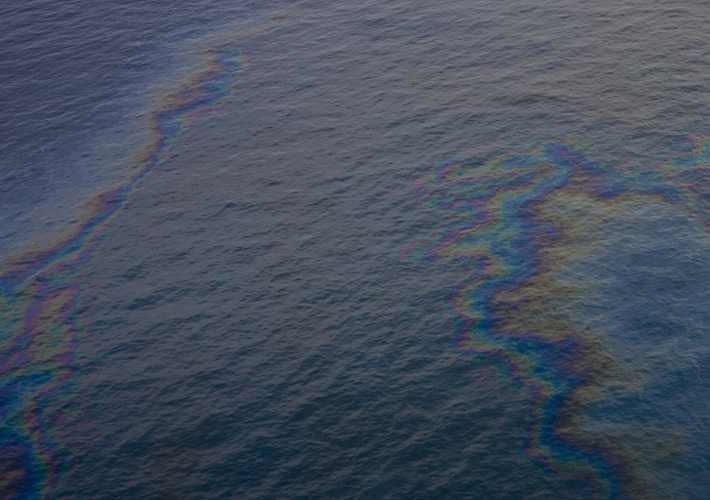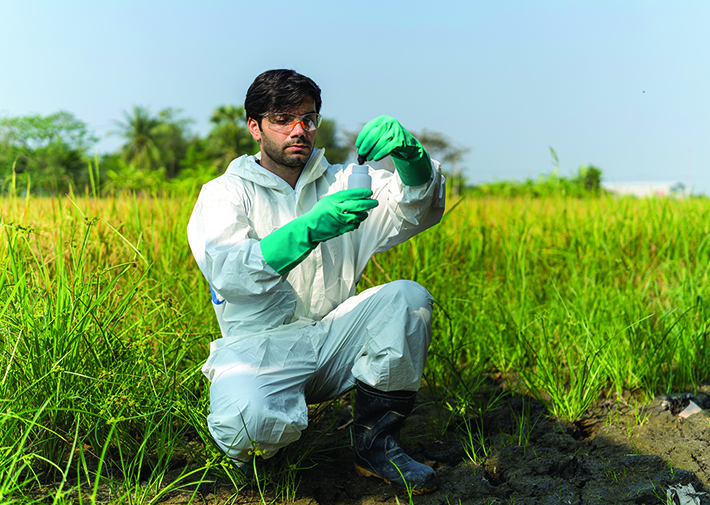
Standards Address Forever Chemicals
“Forever chemicals.” That’s what PFAS are called. PFAS, or per- and polyfluoroalkyl substances, stay together; they have strong bonds.
Paul Sonnenfeld is the chair of the environmental risk management subcommittee (E50.05) and has been an ASTM member since 1993. He summarizes it: “The PFAS carbon-fluorine chemical bond is extremely difficult to break, which is why they’re called forever chemicals.”
Since their introduction around 1950, PFAS have been used in familiar consumer goods such as non-stick cooking pans and stain-resistant clothing, and they have also been a common component of firefighting foams. Today, PFAS include more than 4,000 synthetic chemical compounds (with some sources citing a much
larger number).
READ MORE: The Fight Against PFAS
Their strong bonds also mean that PFAS persist. They have been found in the environment, in soil and water, and in sludge and wastewater without breaking down. And that presence and persistence is coupled with studies indicating adverse effects on human health.
“Remediation technologies previously used to address other recalcitrant chemicals and chlorinated hydrocarbons such as PCBs, PERC [tetrachloroethene], and vinyl chloride are not effective for PFAS,” Sonnenfeld notes.
That’s where ASTM committees come in. They are responding to the PFAS situation with standard guides and methods, both complete and in process, to assess and manage these chemicals.
More About PFAS
PFAS encompasses PFOA (perfluorooctanoic acid) and PFOS (perfluorooctane sulfonate) — no longer made in the United States — and numerous alternatives. Their characteristics result from the linking of carbon and fluorine atoms in a chain, short or long.
As noted in the guide for management of investigation-derived waste associated with PFAS (E3274; more about the standard below), “PFAS can withstand high temperatures and survive highly corrosive environments.” These chemicals repel oil and water, make materials stain-resistant, and as part of cosmetics, cause skin to feel smoother. PFAS also help spread the foams used to suppress flames associated with petroleum fires.
Because of these properties, PFAS became part of a diverse range of products used by many industries and agencies.
At the same time, the strong bonds of these compounds also cause them to persist in the environment without degrading. PFAS have found their way into water, soil, waste, and even food around the world. That also means that most people have been exposed to PFAS in one way or another, and studies show that ongoing exposure can lead to adverse health effects.
As a result, the European Commission is pursuing a further ban on PFAS (as in the United States, where some are also already banned as well) with firefighting foam manufacturing to be prohibited as of this summer. In the United States, the U.S. Environmental Protection Agency (EPA) is expanding PFAS monitoring in drinking water and developing strategies to protect health and the environment.
With the increasing focus on PFAS, the need for analytical methods and guidance is also becoming more important, along with standards to provide common ground.
The Need for Standards
Who needs related standards? “Everyone,” Lawrence Zintek says. Zintek is organic methods developer at the U.S. EPA and a member of the committees on water (D19) and waste management (D34). These two committees, along with the environmental assessment, risk management, and corrective action committee (E50), are all addressing PFAS as part of their standards work.
“ASTM is working to fill a need in the community for guidance on what it means to have a PFAS concern and how to understand it. We’re hoping to illuminate the subtleties and differences that you have to think about,” says Stephanie Fiorenza, Ph.D., a remediation technology specialist and consultant, as well as an E50 member. “The practices that you follow are not going to be exactly the same as those you followed for other contaminants.”
The understanding of PFAS use, its adverse effects, and its persistence in the environment has been increasing. And the standards needs are being clearly delineated as well.

PFAS can remain in the environment for years and harm human health.
Sonnenfeld lists what he sees as the overarching areas of need:
- Site identification and accelerated site characterization,
- Selection of applicable analytical methods,
- Stakeholder engagement,
- Liability recognition and disclosure,
- Waste management, and
- Long-term stewardship.
Professionals representing Industry, regulatory groups (both U.S. state and federal), treatment plants, labs, and environmental consultancies are addressing needs with both completed and draft standards.
New PFAS Guidance
Last year, the environmental assessment, risk management, and corrective action committee (E50) published new standards that help address PFAS. These join existing standards relevant to developing site-specific remediation goals and understanding the costs and liabilities of specific sites.
One is the guide for PFAS analytical methods selection (E3302), approved last October, which gives users information about available procedures.
“It’s a guide that lays out the various analytical methods and helps the user select one for their project. It’s something of a roadmap. Now I have an array of choices. How do I choose a tool with my job that I need to perform?” says Eileen Snyder, regional technical coordinator at Alpha Analytical and an E50 member. “Like a contractor with a toolkit and a job to do, you need to select a tool that’s appropriate for that job to do it successfully. Our charge with the analytical method selection guide was to help the user make sense of this sometimes confusing array of analytical methods.”
Snyder says that the standard is significant because it provides concise descriptions of analytical methods. It also includes considerations for selection of analytical methods for determining PFAS compounds. “The standard is a great step forward because it helps the user identify which analytical methods to use when testing environmental samples for the presence of PFAS; it provides consistency,” Sonnenfeld says.
“This is a fast-moving field,” Snyder adds. “We want to provide users with the most current relevant information. So that’s why, even though we published the guide less than six months ago, we’re already looking to undertake revisions.”
The current standard, and future revisions, will help users from international groups and U.S. regulatory organizations to testing laboratories and environmental professionals.
Also published last year was the guide for management of investigation-derived waste associated with PFAS (E3274).
The waste could be gathered from many places such as borehole soil or other excavation fill, sediments, even solutions from decontaminating sampling and personal protective equipment. Because of the characteristics and persistence of PFAS, special handling and treatment/disposal considerations must be considered. With the standard, users have best practices for managing waste containing PFAS so that it won’t be disposed of into wastewater treatment plants or other places it shouldn’t be.
PFAS Methods
In addition to the guidance standards completed in the E50 committee, the committees on water and waste management are making progress with the development of analytical methods.
Zintek says, “There need to be validated standards for PFAS since every lab, for the most part, is still doing their own thing. The draft EPA 1633 is laborious, and small labs will have a hard time implementing it. We need robust, quick methods like D7968, D7979, and D8421 as viable alternatives. All methods are required to be validated according to EPA or consensus body requirements to ensure data of known and acceptable quality are produced.”
These published procedures are:
Test method for determination of polyfluorinated compounds in soil by liquid chromatography tandem mass spectrometry (LC/MS/MS) (D7968). This method uses a quick extraction process for these chemicals at trace levels in soils to help understand where they originate and where they move.
Test method for determination of per- and polyfluoroalkyl substances in water, sludge, influent, effluent, and wastewater by liquid chromatography tandem mass spectrometry (LC/MS/MS) (D7979). This method provides a qualitative and quantitative approach for trace levels of PFAS in surface water and wastewater and more.
Test method for determination of per- and polyfluoroalkyl substances (PFAS) in aqueous matrices by co-solvation followed by liquid chromatography tandem mass spectrometry (LC/MS/MS) (D8421). This method describes another “quick, easy, and robust method to quantitatively determine these compounds at trace levels in water matrices,” as noted in the standard. The standard includes precision and bias, and validation from various types of waters.
With these standards — and more underway to determine PFAS in different types of water and soil — these committees are responding to the need for analytical tests for PFAS.
Additional Guidance to Come
Fiorenza notes another standard need: how to evaluate data collected from different tests, laboratories, and research. There is some guidance on evaluating data from drinking water methods, but there is much more that is needed, she says.
“Since there isn’t a standard method to analyze matrices other than drinking water samples, labs have developed their own standard operating procedures. There is not an EPA-approved multi-laboratory validated method to analyze samples, other than drinking water, and people are concerned about PFAS in all kinds of matrices,” says Fiorenza. “So it’s not like you can order an analysis at one lab for a different matrix and assume it’s being done the same way when you go to another lab. So you don’t really know how to compare data.”
FOR YOU: The Environmental Site Assessment Standard Gets a Revision
A draft standard — a guide for PFAS data evaluation guidance (WK76460) — will help address that need. The guide will cover critical aspects of assessing, evaluating, and interpreting PFAS data received from analytical laboratories: project planning, data-quality assessment, and ultimately, data validation, evaluation, and usability. The guide gives data validators a multi-faceted tool for reviewing results developed by nonstandard methods.
Also underway is a guide for PFAS site screening and initial characterization (WK73683). Snyder explains the need for this standard. “The heightened awareness of PFAS can lead to an interruption of normal business flow. That is why ASTM has undertaken a logical, science-based, tiered approach for incorporating PFAS considerations into the initial site screening and site-characterization process,” she says.
Sonnenfeld adds that the document will provide insights into how a treatment system can be evaluated to provide effective protection. With PFAS systems in place, lessons learned can become part of the practical guidance.
There are also guides underway for PFAS framework mapping (WK70265), which aim to help users respond to detected PFAS, and for managing a process addressing PFAS released into wastewater streams (WK74176). And revisions now underway will include PFAS in existing standards.
You’re Invited
Environmental consultants, environmental analytical laboratories, laboratory instrument manufacturers, data validators, analytical and project chemists, and U.S. federal agencies such as the U.S. Department of Defense and the U.S. Environmental Protection Agency, are all contributing to the development of these needed standards. All those interested and not yet involved are welcome to become part of this ongoing work.
As Sonnenfeld notes, “Issues related to the release and remediation of PFAS compounds are dynamic. Regulators and members of the regulated community want and need robust standards to guide their responses. ASTM standards help all parties find common ground to address these challenging compounds.” ■
 SN Home
SN Home Archive
Archive Advertisers
Advertisers Masthead
Masthead RateCard
RateCard Subscribe
Subscribe Email Editor
Email Editor